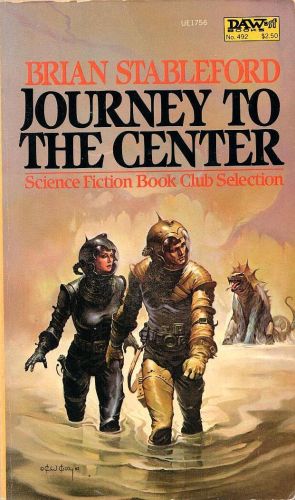

|
| Cover art by Ken W. Kelly |
| JOURNEY TO THE CENTER Brian Stableford New York: DAW Books, August 1982 |
Rating: 5.0 High |
|||
| ISBN-13 978-0-87997-756-6 | ||||
| ISBN-10 0-87997-756-6 | 176pp. | SC | $2.50 | |
The world of Asgard is a mystery. It is thought to have emerged from a dark cloud a few million years ago. The Tetrax found it and set up a base. Now it is home to many individuals from half a hundred species, all striving in their various ways to unravel the secrets of the unknown race that filled it with advanced technology.
Michael Rousseau is a human treasure hunter, long resident on Asgard. He has been reasonably successful at it. But he has competition: both other treasure-hunters and the C.R.E. (coordinated research establishment) in which numerous races combine their efforts in a methodical, scientific effort to uncover and catalog the secrets of the world and its former inhabitants. The C.R.E. does what it can to discourage independent hunters.
The Tetrax, a notably polite and law-abiding species, are in charge. But crime persists, and Rousseau is quickly enmeshed in it when a traveler known as Myrlin arrives from offworld. Protocol requires a resident to take responsibility for any visitor, and a C.R.E official has nominated Michael Rousseau for this duty. But Rousseau declines in favor of Saul Lyndrach, an even more accomplished treasure-hunter. And that is how it plays out.
But Rousseau is framed for murder after getting involved in a fight over a card game, and then Lyndrach turns up in Rousseau's apartment — quite deceased. Myrlin has disappeared, and a Terran star-captain turns up at Rousseau's trial in the nick of time to save him from court-mandated bondage to Amara Guur, a local crime boss. Rousseau suspects Guur was behind his framing, and infers Lyndrach must have made some unprecedented discovery about Asgard. The star-captain, Susarma Lear, has her own motive for intervening: Myrlin, she reveals, is a dangerous android produced by the enemy Terran forces recently defeated in an interstellar war. Determined to pursue and eliminate the android, the beautiful star-captain1 conscripts Rousseau into the Terran Star Force.
Indications are that Myrlin has stolen Rousseau's truck and gone into the interior: the largely unknown territory below the surface of Asgard, where frigid layers proceed to undetermined depths. After equipping themselves, the star-captain and her guards advance into the interior, a reluctant Michael Rousseau in tow. Following Saul Lyndrach's notebook, which an employee of Guur's gave to Rousseau when they still hoped to control him, Rousseau leads the small force along a path Lyndrach mapped out. They make it to the fourth level, where temperatures are warmer. Crossing a swamp, they are attacked by something like a house-sized amoeba and Rousseau is separated from the others. He runs away as the others fight the creature. (They are enveloped, but not harmed.)
Finding himself free to go his own way, he soon spots a long-decayed railroad track and walks along it until he reaches a station building. There he beds down and sleeps soundly — so soundly that Myrlin is able to take away the flame-pistol the star-captain gave him. They have a long talk. It turns out that Myrlin is not exactly as the star-captain described him. Neither, for that matter, is the C.R.E. And when Rousseau and his unwanted companions encounter the residents dwelling thousands of levels deep within Asgard, they too are nothing like what any of the explorers imagined they would be.
They were two insoluble problems. I didn't know the answer to either of them, and I never would. My instinct was to trust my judgment that the Salamandran project had failed and that what I remembered about the world far below was true . . but we all know what happens to people who put too much trust in their instincts. Look at Amara Guur, to name but one. In the end, I decided to accept the apparent truth as the genuine article. There's nothing to be gained from constantly puzzling over the insoluble. In the famous last words of one of the most profound philosophical documents ever penned by a human hand, il faut cultiver notre jardin. At least, in Asgard, I had the biggest bloody jardin in the known universe. – Pages 175-176 |
The tale is complex, but very well constructed. Stableford gives us good characters and sharp dialog, and he includes some very inventive technology. And there is a very interesting venture into epistemology at the end. It is a superior tale in all respects. Full marks.

 To contact Chris Winter, send email to this address.
To contact Chris Winter, send email to this address.